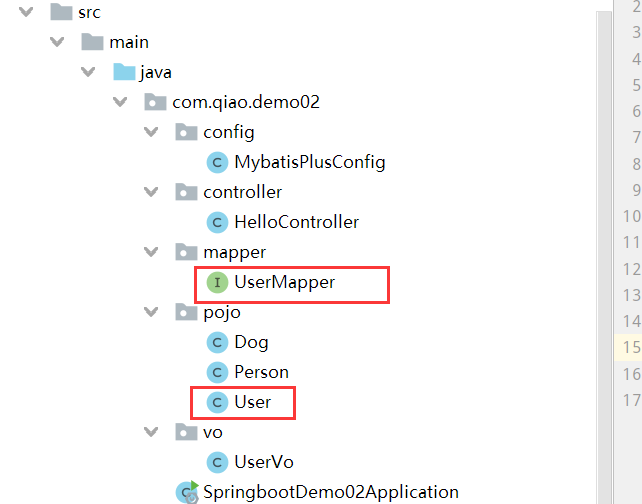您好,登錄后才能下訂單哦!
您好,登錄后才能下訂單哦!
今天就跟大家聊聊有關使用mybatis-plus如何實現分頁查詢功能,可能很多人都不太了解,為了讓大家更加了解,小編給大家總結了以下內容,希望大家根據這篇文章可以有所收獲。
引入依賴:
<!-- 引入mybatisPlus --> <dependency> <groupId>com.baomidou</groupId> <artifactId>mybatis-plus-boot-starter</artifactId> <version>3.2.0</version> </dependency> <!-- 引入mysql驅動包 --> <dependency> <groupId>mysql</groupId> <artifactId>mysql-connector-java</artifactId> <version>5.1.27</version> </dependency> <!-- 引入Druid依賴,阿里巴巴所提供的數據源 --> <dependency> <groupId>com.alibaba</groupId> <artifactId>druid</artifactId> <version>1.0.29</version> </dependency>
在application.yml配置
spring: datasource: type: com.alibaba.druid.pool.DruidDataSource driver-class-name: com.mysql.jdbc.Driver url: jdbc:mysql://127.0.0.1:3306/test?useUnicode=true&characterEncoding=UTF-8 username: root password: 123456
在啟動類上面添加@MapperScan注解,掃描mapper包
@SpringBootApplication
@MapperScan("com.qiao.demo02.mapper")
public class SpringbootDemo02Application {
public static void main(String[] args) {
SpringApplication.run(SpringbootDemo02Application.class, args);
}
}新建User和UserMapper

user類
@Data
public class User {
@TableId
private Integer userId;
private String userName;
private Integer userAge;
private String userEmail;
}UserMapper接口
public interface UserMapper extends BaseMapper<User> {
}最重要的是繼承BaseMapper<E>接口:里面聲明了很強大的CRUD方法
public interface BaseMapper<T> extends Mapper<T> {
int insert(T entity);
int deleteById(Serializable id);
int deleteByMap(@Param("cm") Map<String, Object> columnMap);
int delete(@Param("ew") Wrapper<T> wrapper);
int deleteBatchIds(@Param("coll") Collection<? extends Serializable> idList);
int updateById(@Param("et") T entity);
int update(@Param("et") T entity, @Param("ew") Wrapper<T> updateWrapper);
T selectById(Serializable id);
List<T> selectBatchIds(@Param("coll") Collection<? extends Serializable> idList);
List<T> selectByMap(@Param("cm") Map<String, Object> columnMap);
T selectOne(@Param("ew") Wrapper<T> queryWrapper);
Integer selectCount(@Param("ew") Wrapper<T> queryWrapper);
List<T> selectList(@Param("ew") Wrapper<T> queryWrapper);
List<Map<String, Object>> selectMaps(@Param("ew") Wrapper<T> queryWrapper);
List<Object> selectObjs(@Param("ew") Wrapper<T> queryWrapper);
IPage<T> selectPage(IPage<T> page, @Param("ew") Wrapper<T> queryWrapper);
IPage<Map<String, Object>> selectMapsPage(IPage<T> page, @Param("ew") Wrapper<T> queryWrapper);
}分頁查詢
這點官方文檔講的也很詳細:https://mp.baomidou.com/guide/page.html
新建一個config包,在里面建一個MybatisPlus配置類 返回一個分頁攔截器
package com.qiao.demo02.config;
@Configuration
@ConditionalOnClass(value = {PaginationInterceptor.class})
public class MybatisPlusConfig {
@Bean
public PaginationInterceptor paginationInterceptor() {
PaginationInterceptor paginationInterceptor = new PaginationInterceptor();
return paginationInterceptor;
}
}這樣就能使用mybatis的分頁功能了
Junit測試
@Resource
private UserMapper userMapper;
@Test
public void queryUserForPage(){
IPage<User> userPage = new Page<>(2, 2);//參數一是當前頁,參數二是每頁個數
userPage = userMapper.selectPage(userPage, null);
List<User> list = userPage.getRecords();
for(User user : list){
System.out.println(user);
}
}Controller返回json串
先定義一個包裝類UserVo,用來保存分頁所需要的數據
package com.qiao.demo02.vo;
@Data
public class UserVo {
private Integer current;
private Integer size;
private Long total;
private List<User> userList;
}然后在控制器編寫代碼,這里省略了service層,實際開發業務代碼寫在service層,Controller只負責:接受參數、調用service層方法處理業務邏輯,返回結果
Controller類貼上了@RestController注解
@GetMapping("queryUser")
public UserVo queryList(Integer current, Integer size) {
/**
* 這些代碼應該寫在service層
*/
UserVo userVo = new UserVo();
IPage<User> page = new Page<>(current, size);
userMapper.selectPage(page, null);
userVo.setCurrent(current);
userVo.setSize(size);
userVo.setTotal(page.getTotal());
userVo.setUserList(page.getRecords());
return userVo;
}附上結果,前端直接處理json數據即可

看完上述內容,你們對使用mybatis-plus如何實現分頁查詢功能有進一步的了解嗎?如果還想了解更多知識或者相關內容,請關注億速云行業資訊頻道,感謝大家的支持。
免責聲明:本站發布的內容(圖片、視頻和文字)以原創、轉載和分享為主,文章觀點不代表本網站立場,如果涉及侵權請聯系站長郵箱:is@yisu.com進行舉報,并提供相關證據,一經查實,將立刻刪除涉嫌侵權內容。